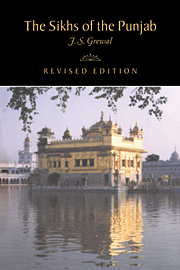Book contents
- Frontmatter
- Introduction
- 1 The Turko-Afghan Rule
- 2 Foundation of the Sikh Panth
- 3 Evolution of the Sikh Panth (1539–1606)
- 4 Transformation of the Sikh Panth (1606–1708)
- 5 Rise to political power (1708–1799)
- 6 The Sikh empire (1799–1849)
- 7 Recession and resurgence (1849–1919)
- 8 In the struggle for freedom (1920–1947)
- 9 Towards the ‘Punjabi Province’ (1947–1966)
- 10 In the new Punjab state (1966–1984)
- Bibliographical essay
- Index
- THE NEW CAMBRIDGE HISTORY OF INDIA
- Frontmatter
- Introduction
- 1 The Turko-Afghan Rule
- 2 Foundation of the Sikh Panth
- 3 Evolution of the Sikh Panth (1539–1606)
- 4 Transformation of the Sikh Panth (1606–1708)
- 5 Rise to political power (1708–1799)
- 6 The Sikh empire (1799–1849)
- 7 Recession and resurgence (1849–1919)
- 8 In the struggle for freedom (1920–1947)
- 9 Towards the ‘Punjabi Province’ (1947–1966)
- 10 In the new Punjab state (1966–1984)
- Bibliographical essay
- Index
- THE NEW CAMBRIDGE HISTORY OF INDIA
Summary
For every twenty Sikhs in the Punjab there are no more than four in the rest of India and not more than one in the rest of the world; among those who live outside, there are not many who do not have their roots in the Punjab.
The literal meaning of the Persian term panj-āb is ‘five-waters’. It was meant to signify the land of five rivers. But it was not meant to be taken literally. When it became current in the reign of Akbar in the late sixteenth century, it was synonymous with the province of Lahore and, therefore, actually smaller than the area lying between the rivers Indus and Satlej. The British Punjab, however, embraced the entire plain between the Jamuna and the Indus. This region had a geographical entity of its own. Its southern boundary was marked by a desert in historical times. The Himalayas stood in its north even before the Punjab plains emerged as a geological entity.
As a geographical region, the Punjab was probably wetter in prehistoric times, but there has been little climatic change during the Christian era. The rains of July and August mark the end of the extreme heat of May and June, and the return of the spring in March and April marks the end of the extreme cold of December and January. The most temperate weeks come in February-March and October-November. The rivers have changed course from time to time. The river Sarswati, which either fell directly into the Arabian Sea or joined the Indus during the second millennium before Christ, is now marked by the stream called Ghaggar and its dry bed. This was a major change.
- Type
- Chapter
- Information
- The Sikhs of the Punjab , pp. 1 - 8Publisher: Cambridge University PressPrint publication year: 1991

